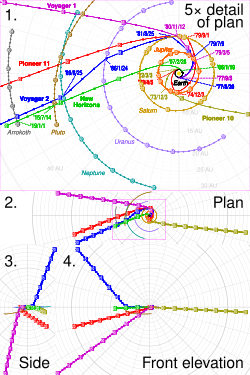
Back Voyager 1 Afrikaans Voyager 1 ALS Voyager 1 AN فوياجر 1 Arabic ভয়েজাৰ ১ Assamese Voyager 1 AST Voyacer 1 Azerbaijani وویجر ۱ AZB Voyager 1 BAT-SMG Вояджэр-1 Byelorussian
 Artist's rendering of the Voyager spacecraft design | |||||||||||||||||||||||||
| Mission type | Outer planetary, heliosphere, and interstellar medium exploration | ||||||||||||||||||||||||
|---|---|---|---|---|---|---|---|---|---|---|---|---|---|---|---|---|---|---|---|---|---|---|---|---|---|
| Operator | NASA/Jet Propulsion Laboratory | ||||||||||||||||||||||||
| COSPAR ID | 1977-084A[1] | ||||||||||||||||||||||||
| SATCAT no. | 10321[1] | ||||||||||||||||||||||||
| Website | science | ||||||||||||||||||||||||
| Mission duration |
elapsed
| ||||||||||||||||||||||||
| Spacecraft properties | |||||||||||||||||||||||||
| Spacecraft type | Mariner Jupiter-Saturn | ||||||||||||||||||||||||
| Manufacturer | Jet Propulsion Laboratory | ||||||||||||||||||||||||
| Launch mass | 815 kg (1,797 lb)[2] | ||||||||||||||||||||||||
| Dry mass | 721.9 kg (1,592 lb)[3] | ||||||||||||||||||||||||
| Power | 470 watts (at launch) | ||||||||||||||||||||||||
| Start of mission | |||||||||||||||||||||||||
| Launch date | September 5, 1977, 12:56:01 UTC | ||||||||||||||||||||||||
| Rocket | Titan IIIE | ||||||||||||||||||||||||
| Launch site | Cape Canaveral Launch Complex 41 | ||||||||||||||||||||||||
| End of mission | |||||||||||||||||||||||||
| Last contact | 2036 (estimated) | ||||||||||||||||||||||||
| Flyby of Jupiter | |||||||||||||||||||||||||
| Closest approach | March 5, 1979 | ||||||||||||||||||||||||
| Distance | 349,000 km (217,000 mi) | ||||||||||||||||||||||||
| Flyby of Saturn | |||||||||||||||||||||||||
| Closest approach | November 12, 1980 | ||||||||||||||||||||||||
| Distance | 124,000 km (77,000 mi) | ||||||||||||||||||||||||
| Flyby of Titan (atmosphere study) | |||||||||||||||||||||||||
| Closest approach | November 12, 1980 | ||||||||||||||||||||||||
| Distance | 6,490 km (4,030 mi) | ||||||||||||||||||||||||
| |||||||||||||||||||||||||
Large Strategic Science Missions (Planetary Science Division) | |||||||||||||||||||||||||

Plot 1 is viewed from the north ecliptic pole, to scale.
Plots 2 to 4 are third-angle projections at 20% scale.
In the SVG file, hover over a trajectory or orbit to highlight it and its associated launches and flybys.
Voyager 1 is a space probe launched by NASA on September 5, 1977, as part of the Voyager program to study the outer Solar System and the interstellar space beyond the Sun's heliosphere. It was launched 16 days after its twin, Voyager 2. It communicates through the NASA Deep Space Network (DSN) to receive routine commands and to transmit data to Earth. Real-time distance and velocity data are provided by NASA and JPL.[4] At a distance of 167.34 AU (25.0 billion km; 15.6 billion mi) from Earth as of February 2025[update],[4] it is the most distant human-made object from Earth.[5] The probe made flybys of Jupiter, Saturn, and Saturn's largest moon, Titan. NASA had a choice of either doing a Pluto or Titan flyby; exploration of the moon took priority because it was known to have a substantial atmosphere.[6][7][8] Voyager 1 studied the weather, magnetic fields, and rings of the two gas giants and was the first probe to provide detailed images of their moons.
As part of the Voyager program and like its sister craft Voyager 2, the spacecraft's extended mission is to locate and study the regions and boundaries of the outer heliosphere and to begin exploring the interstellar medium. Voyager 1 crossed the heliopause and entered interstellar space on August 25, 2012, making it the first spacecraft to do so.[9][10] Two years later, Voyager 1 began experiencing a third wave of coronal mass ejections from the Sun that continued to at least December 15, 2014, further confirming that the probe is in interstellar space.[11]
In 2017, the Voyager team successfully fired the spacecraft's trajectory correction maneuver (TCM) thrusters for the first time since 1980, enabling the mission to be extended by two to three years.[12] Voyager 1's extended mission is expected to continue to return scientific data until at least 2025, with a maximum lifespan of until 2030.[13] Its radioisotope thermoelectric generators (RTGs) may supply enough electric power to return engineering data until 2036.[14]
- ^ a b "Voyager 1". NSSDC Master Catalog. NASA/NSSDC. Archived from the original on January 30, 2017. Retrieved August 21, 2013.
- ^ "NASA – Voyager Facts". NASA's Goddard Space Flight Center website. Archived from the original on December 10, 2022. Retrieved May 20, 2023.
- ^ "Voyager 1". NASA's Solar System Exploration website. December 6, 2017. Archived from the original on April 18, 2019. Retrieved December 4, 2022.
- ^ a b "Voyager – Mission Status". Jet Propulsion Laboratory. National Aeronautics and Space Administration. Archived from the original on January 1, 2018. Retrieved May 1, 2024.
- ^ "Voyager 1". BBC Solar System. Archived from the original on February 3, 2018. Retrieved September 4, 2018.
- ^ Cite error: The named reference
nasa-1990was invoked but never defined (see the help page). - ^ "New Horizons conducts flyby of Pluto in historic Kuiper Belt encounter". July 12, 2015. Archived from the original on September 6, 2015. Retrieved September 2, 2015.
- ^ "What If Voyager Had Explored Pluto?". Archived from the original on April 13, 2020. Retrieved September 2, 2015.
- ^ "Interstellar Mission". NASA Jet Propulsion Laboratory. Archived from the original on September 14, 2017. Retrieved August 24, 2020.
- ^ Barnes, Brooks (September 12, 2013). "In a Breathtaking First, NASA Craft Exits the Solar System". New York Times. Archived from the original on March 11, 2020. Retrieved September 12, 2013.
- ^ Claven, Whitney (July 7, 2014). "Sun Sends More 'Tsunami Waves' to Voyager 1". NASA. Archived from the original on December 21, 2018. Retrieved July 8, 2014.
- ^ Wall, Mike (December 1, 2017). "Voyager 1 Just Fired Up its Backup Thrusters for the 1st Time in 37 Years". Space.com. Archived from the original on December 3, 2017. Retrieved December 3, 2017.
- ^ "Voyager 1 Launched 40 Years Ago Today". American Museum of Natural History. September 5, 2017. Archived from the original on May 2, 2024. Retrieved May 2, 2024.
- ^ "Voyager – Frequently Asked Questions". Jet Propulsion Laboratory. Archived from the original on August 13, 2023. Retrieved July 30, 2020.